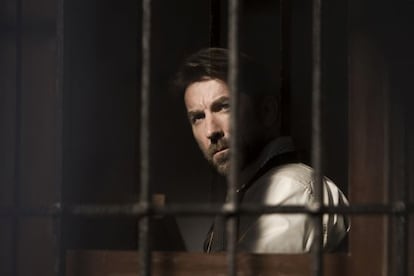Nice to eat you
Antonio de la Torre gets his teeth into his first bona fide leading role in the acclaimed ‘Cannibal’

Of all the many possible ways of winning the role of a serial killer who eats his female victims, Antonio de la Torre took the most mundane. After reading the script, he went to the audition with a piece of steak in a plastic container, which he heated up in the microwave of the casting office and then ate in front of director and screenwriter Manuel Martín Cuenca. Watching a normal-looking guy cut up a normal-looking steak and taste it in a normal-looking way can be terrifying when you’re aware of where the meat has come from.
The evil lurking in everyday life is at the heart of Martín Cuenca’s Cannibal. The film alights on those little domestic moments such as a conventional-looking guy placing pieces of steak wrapped in plastic into the freezer. For the director, the horror lay in those small gestures, but he had yet to put them into images. And that’s what De la Torre did with his Tupperware box. “He sat down, he ate the steak... And there I saw the film. I saw it.”
Little had been said about the movie, which is released in Spain on Friday, until a review appeared in The Hollywood Reporter following its screening at the Toronto Film Festival a few weeks ago; soon after it appeared among the list of films preselected to represent Spain at the Oscars. The piece mentioned its “chilling and moving” portrait of a cannibal and praised De la Torre’s work, calling it a “career-best performance” that looks like “a concerted attempt to undo Sir Anthony Hopkins’ cliché-inspiring work in The Silence of the Lambs.”
The accumulation of adjectives elicits a vulgar outburst from the actor as soon as he sits down on the terrace of a bar next to Madrid’s Casa de Campo park. But he soon corrects himself: “I’m happy, of course.” It’s the middle of the afternoon on a Thursday and the actor, as if still immersed in the double life of his Cannibal character — an elegant and lonely tailor on the surface; a brutal predator underneath — soon needs to run off across town to promote another film, Daniel Sánchez Arévalo’s La gran familia española, on a TV show.
Antonio gives everything. He doesn’t go anywhere on autopilot”
That film was also preselected for the Oscars, meaning two of the three films in which De la Torre has appeared this year have been liked, at least, by the members of the Spanish Film Academy (the third is Pedro Almodóvar’s I’m So Excited). It doesn’t surprise Martín Cuenca: “It is incredible to see where Antonio has got to from where he was 20 years ago. He doesn’t take on a role without giving everything. He doesn’t go anywhere on autopilot. He has grown line by line.”
The relationship between the two goes back to the days before either of them had made a name for themselves. They crossed paths for the first time on the set of Hola, ¿estas sola? (1995) on which Martín Cuenca was assistant director and De la Torre had his first speaking appearance on film. They met again on Flores de otro mundo (1999), after Martín Cuenca had called him to appear in his first short, Hombres sin mujeres. Ten years later, after both had hit the big time, he called on him again for TV movie El tesoro and also made space for him in his last film La mitad de Óscar (2010).
De la Torre admits he had begun to feel like he had been left out of the limelight. “I didn’t understand why they didn’t give me roles if I was very good. I asked myself, Why don’t they let me out on the pitch? Just give me a chance, even if it’s the second half, you’ll see how I can revolutionize the match.”
Before becoming an actor, De la Torre was a sports journalist for Andalusian TV network Canal Sur, for a time combining both jobs. In 2007, when he won the Goya Award for Best Supporting Actor for Sánchez Arévalo’s feature debut Dark Blue Almost Black, he dedicated his prize to his TV colleagues, who would cover his back and swap shifts with him. Two months later, they gave him a permanent contract at the station. He asked for a leave of absence. Since then he has been nominated for four more Goyas, but has yet to win again.
He spent two months preparing for his role with a real-life tailor
De la Torre says that more than a method, the acting process for him is “a question of confidence, of willpower, of mood.” He likes to work in such a way that if he is playing a waiter, any waiter will see themselves reflected in his performance. “I always say: I don’t play characters, I play people. This afternoon, a policeman stopped me, asked for a photo and said to me, ‘In Unit 7 you seemed like one of my colleagues’.”
He spent two months preparing for his role in Cannibal with a real-life tailor and studied the leopards at Madrid zoo — just a short walk from his apartment in the Batán neighborhood (although he lives in Seville with his family) — to capture the restraint shown by his cannibal character.
But that’s his job. After that someone has to notice it. Someone like Sánchez Arévalo. De la Torre appeared in two of his early shorts, then one day he told him: “Antonio, nobody has written you a role to match your talent. I am going to do it in my next film.” That’s how the Goya arrived.
But it was still a few years before he got his teeth into his first role as the “absolute star who appears in 100 percent of the scenes,” as Martín Cuenca says. And on that occasion there was a steak on the plate.








































